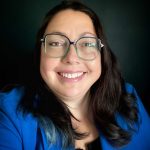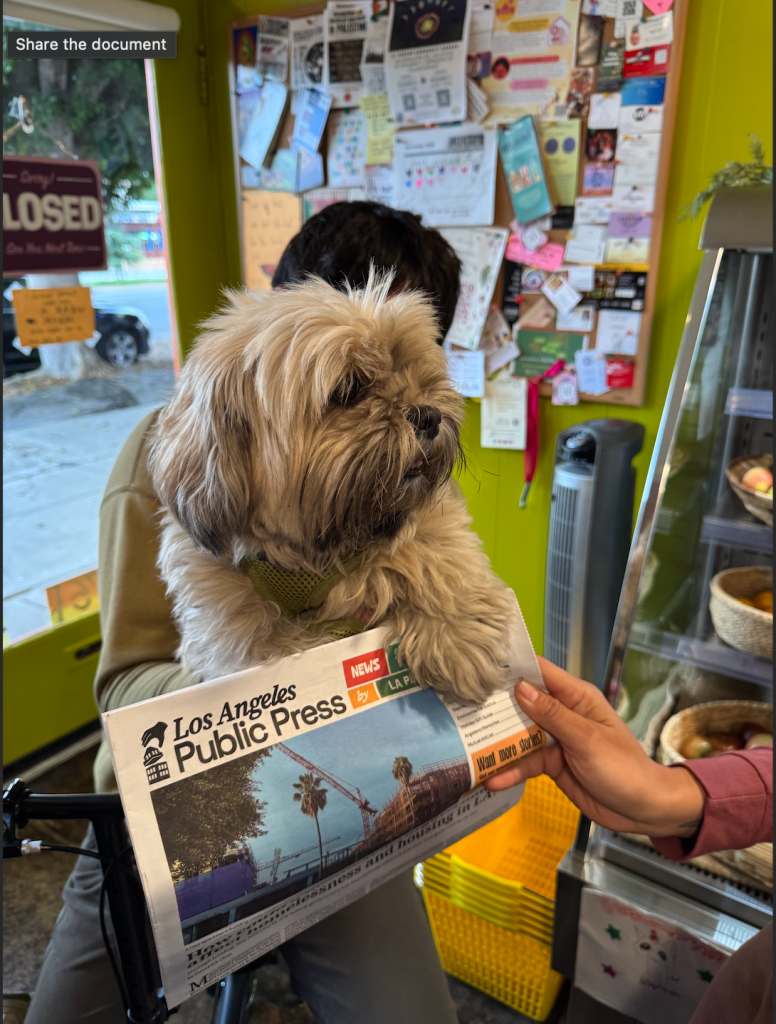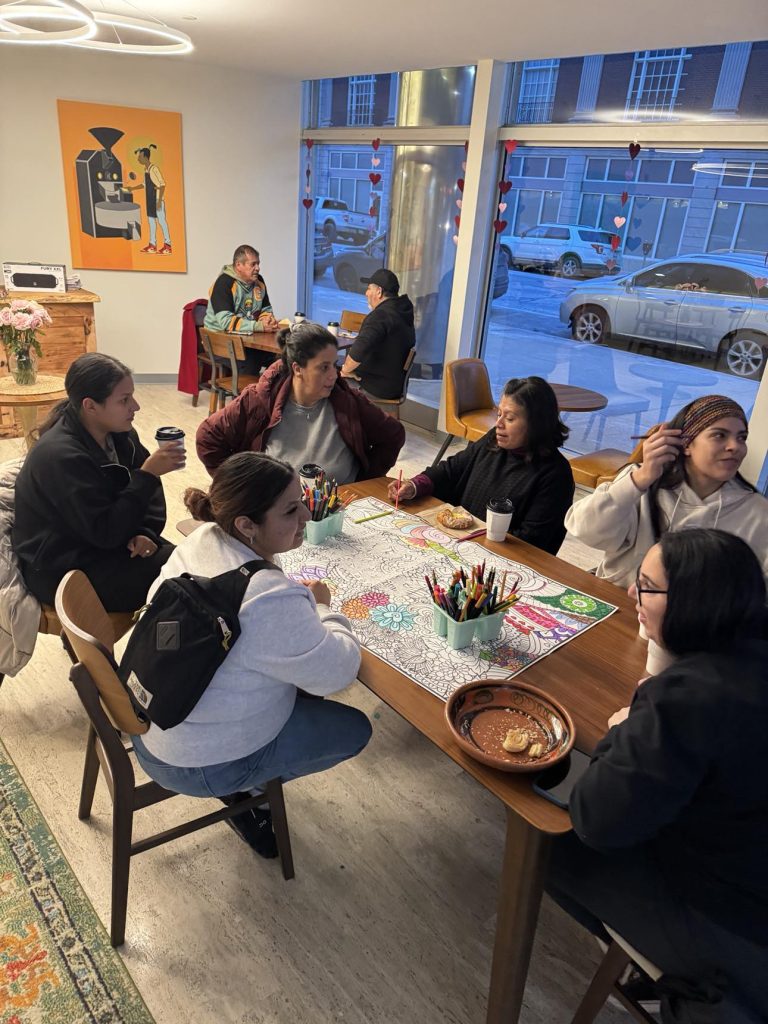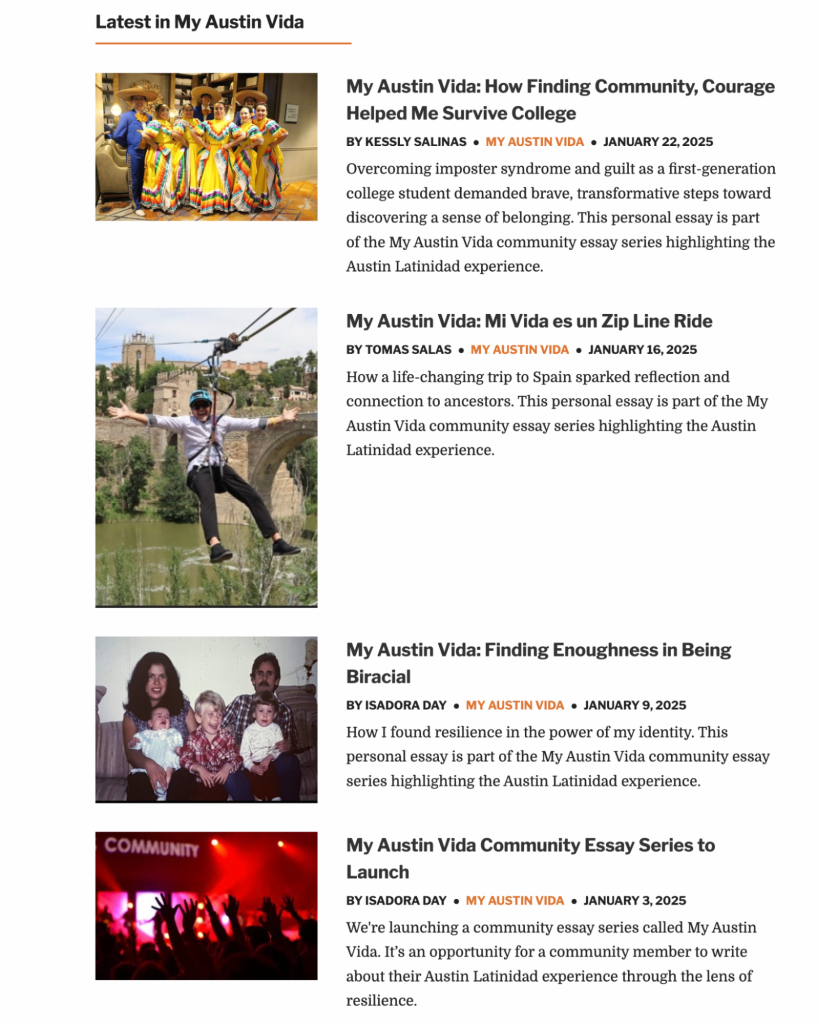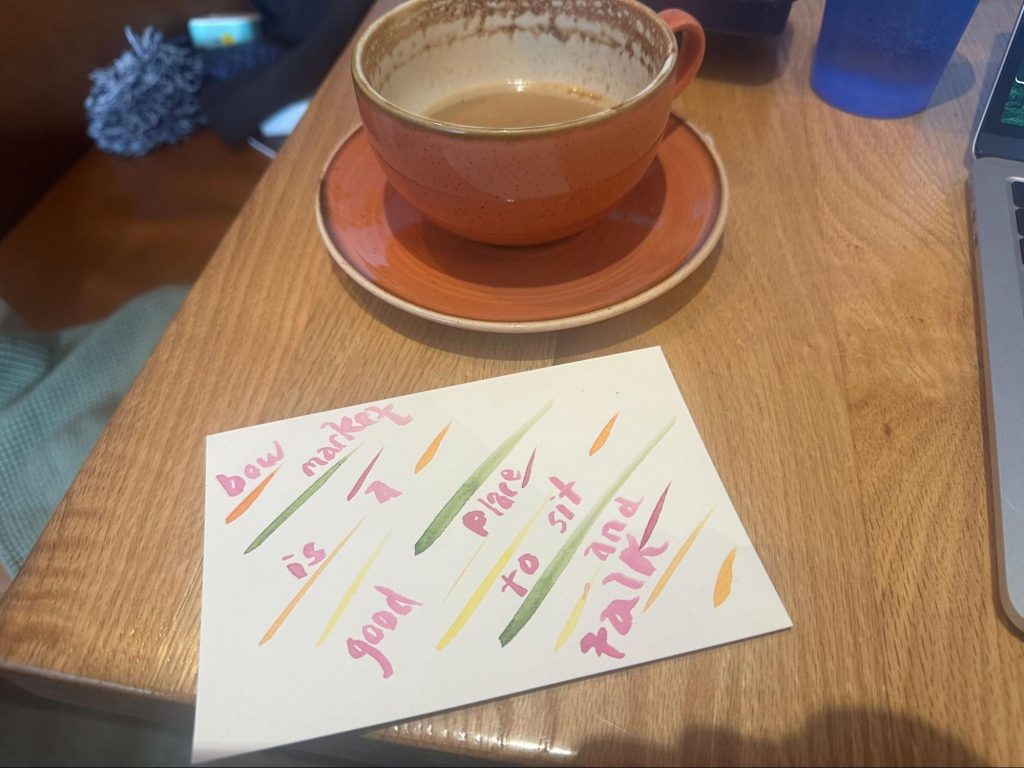
The 2024 Community-Centered Symposium cohort.
12 community-centered news projects
From positivity polls to print editions and photo contests, newsrooms across the country tried a new-to-them idea
Jump to
Bay Area News Group / Mercury News | Jozef Syndicate | La Voz/Arizona Republic | Mirror Indy | LA Public Press | Planeta Venus | Austin Vida | Foothills Forum | Axios Boston | The Green Line | Canopy Atlanta | Minnesota Women’s Press
In October 2024, 25 journalists from community-centered newsrooms and roles across the country came together at the Reynolds Journalism Institute.
The mission of our Community-Centered Symposium is to help journalists share their unique challenges, build collaborative solutions and pursue new innovative ideas for their newsrooms. Through the symposium they build a cohort of inspiration and support for the vital work they do in service to their communities. Building confidence and getting feedback are two aspects of idea development that are sometimes elusive for smaller news organizations.
Each participant in the symposium walks away with practical and new-to-them projects and a plan to launch at least one in their community with the support of RJI and their cohort over the following months.
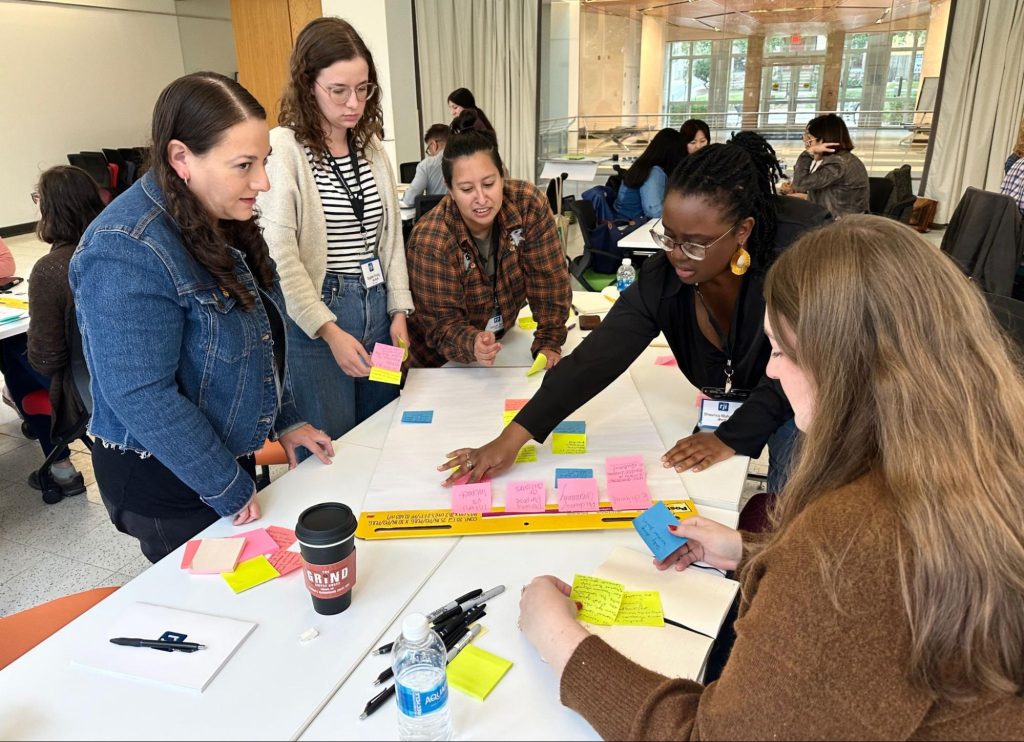
Now, six months later, we’re thrilled to share some of the projects that came out of last year’s symposium and what each newsroom learned.
Bay Area News Group / Mercury News
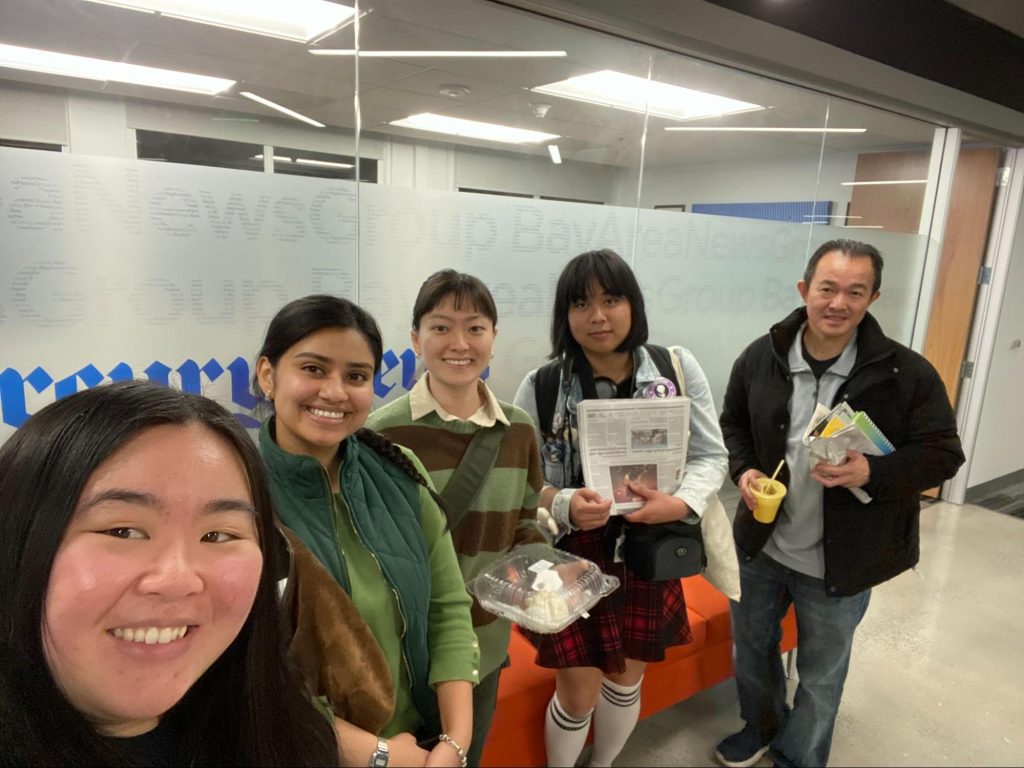
My project deviated from my initial idea of implementing a job shadowing program between journalists in my newsroom and community college/university students. What I ended up doing instead was 1) Running a month-long boot camp reviewing the basics of pitching, reporting and writing that was free for all college students to attend and 2) Creating Zines outlining ways to support local news and distributing them to high school and college newsrooms.
The goal for providing the boot camp was to strengthen the Mercury’s connection with local students. By inviting them in-person to the newsroom, showing them a behind-the-scenes look at the process of making a story, and carving time to answer their questions, participants said they felt encouraged to continue pursuing journalism and participating in student media/internship opportunities. The Zine served a similar purpose. Space was limited in the boot camp, but with the Zines (and matching custom pens!) the Mercury was able to distribute them more easily to different people, providing more opportunities to showcase the organization’s growing community involvement while giving journalism students an encouraging gift to remember them by.
The participants gave encouraging feedback — many said they were grateful for the opportunity, that the camp renewed their interest in reporting and inspired them to one day apply to the Mercury or stay local to work for other outlets. The professors/teachers I distributed the Zines to said they appreciated the Mercury reaching out to schools and taking an interest in students’ educational journey.
I learned that outreach takes a lot of conscious effort and networking! It takes a lot of time communication and coordination to make sure the outreach is effective, and I really needed to carve out time during my work days and off hours to handle it. But in the end, it was definitely worth the effort. I learned that there is a huge appetite in the community college/university journalism sphere for more connection between media organizations and students. Many students in the area — especially those who go to college and transfer to state schools, lack access to the same job/internship/networking opportunities as those from prestigious universities. By reaching out to these different students’ newsrooms, the Mercury helped to address that gap and hopefully make it smaller.
My advice to other newsrooms and journalists who want to try is — encourage a “team effort,” mindset for carrying out this project in the newsroom, and then schedule consistent time to meet and make sure everyone is able to help/on the same page. I found it was hard to recruit some of my co-workers to help — many were interested but understandably had other assignments to address, and weren’t able to commit.
Shared by Stephanie Lam
Jozef Syndicate
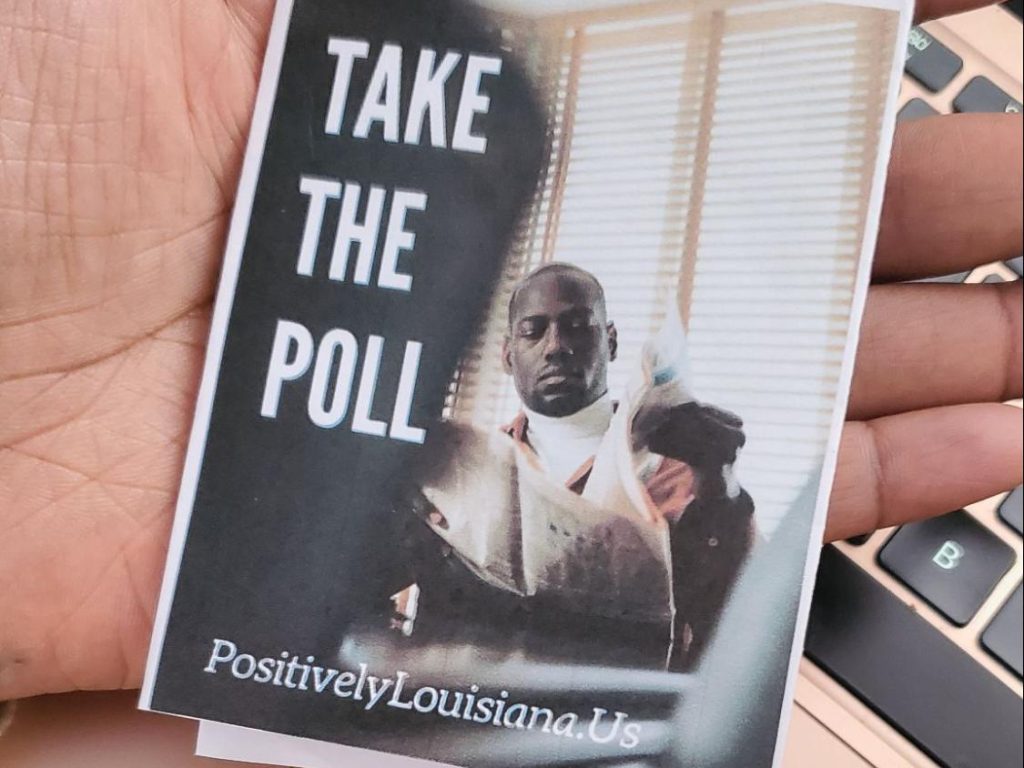
We created Positively Louisiana to curate the joy, happiness, success, and excitement of Louisianans. Using polls, surveys, personal narratives, videos, and local art we highlight what keeps us hopeful and resilient in the face of transition. Positively Louisiana is an online experience celebrating happiness and the electric joy of Louisiana to promote togetherness and pride.
Every aspect of this project was new: creating a list of poll questions, designing a zine, finding a better poll/survey program, We created a webpage PositivelyLouisiana.US to host the survey question, present the results, and announce winners and community partners who gave away prizes. We used news articles, NewsBreak app, and Instagram @PositivelyLouisiana #PositivelyLouisiana to distribute the poll. Mini zines were created and printed for two surveys to test our ability to produce zines and to see how the community received the poll’s positivity concept.
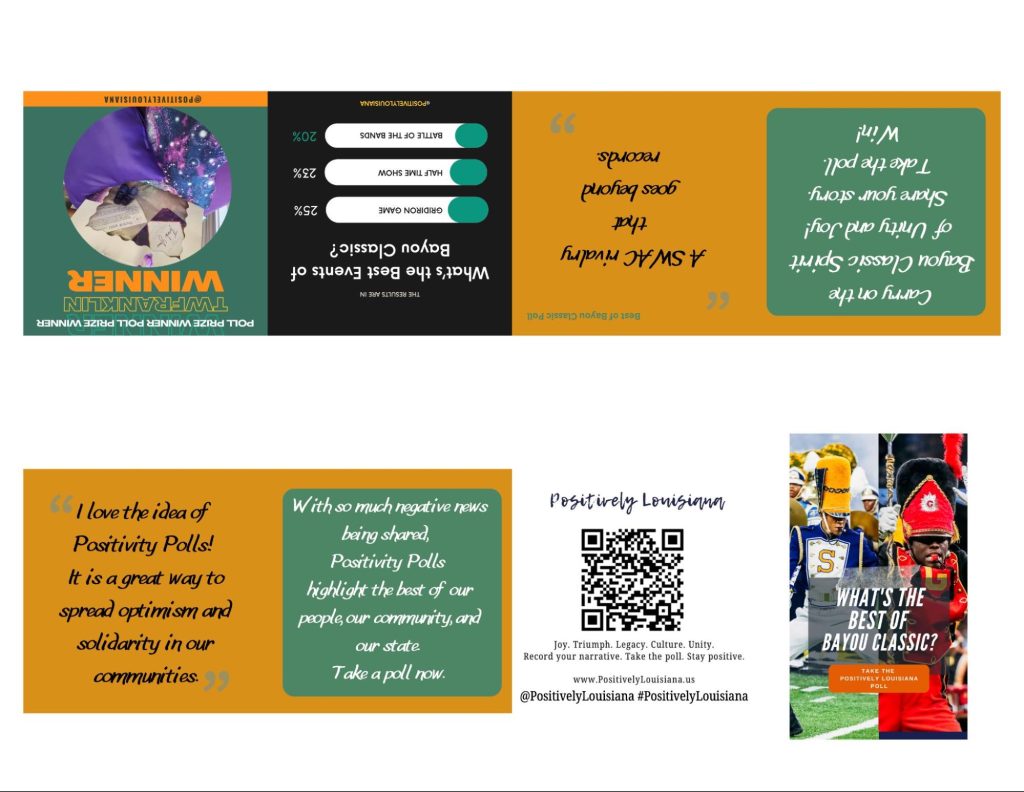
Some feedback we got from the positivity polls:
“I love the idea of Positivity Polls! It is a great way to spread optimism and solidarity in our communities.”
“I thought it was great. People should enjoy completing the survey.”
“Wonderful and Amazing!!”
“Awesome concept and interesting. I like how this continuously emphasizes the word POSITIVE!”
“Thanks for allowing us to share”
“Yes. Yes. I love this. Can I send it to others?”
We learned this concept works best with a reporter and a salesperson in partnership. The reporter will gain more story ideas and connection from the responses while the salesperson can gain ad / barter partners. We plan to expand the poll’s presence by going into third spaces and invite people to complete the poll on the spot, share a story (i.e. quick interview), and win a prize by sharing on social media. We have new community voices on local radio who will promote the polls and join in story telling as a result of printing the promotional zines. Lastly, this pulled our team out of the comfortable routine of story gathering and gave us a fun product.
Shared by Candace Semien
La Voz/Arizona Republic
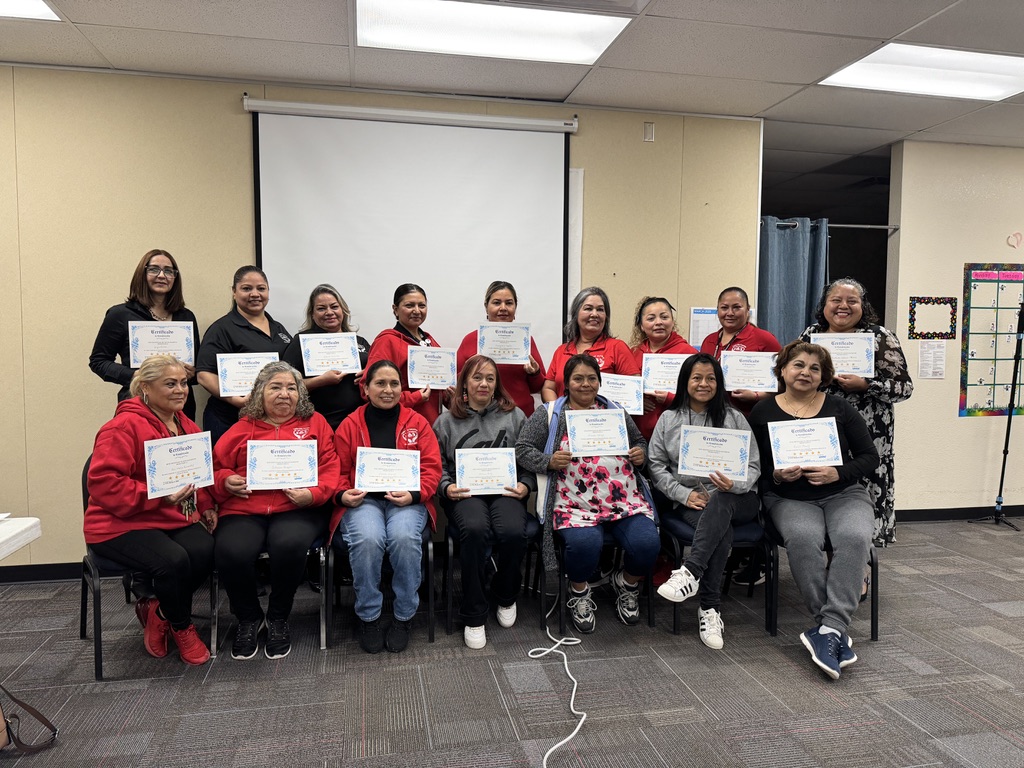
The La Voz/Arizona Republic team, composed of about 10 bilingual newsroom members, hosted a multi-session workshop in the mostly Spanish-speaking neighborhood of Estrella Village, located in southwest Phoenix. The Spanish-language program focused on equipping residents with the tools to combat mis and disinformation, and the structural and writing skills to formulate op-eds and submit them to their local Spanish-language paper. About 20 women of all ages participated, most of whom are heavily involved in the local neighborhood association. One op-ed has been published as of April 29, with two more incoming. Phase two of this project is still in the works, and that involves developing a neighborhood resource guide that will be available online and in print by the summer.
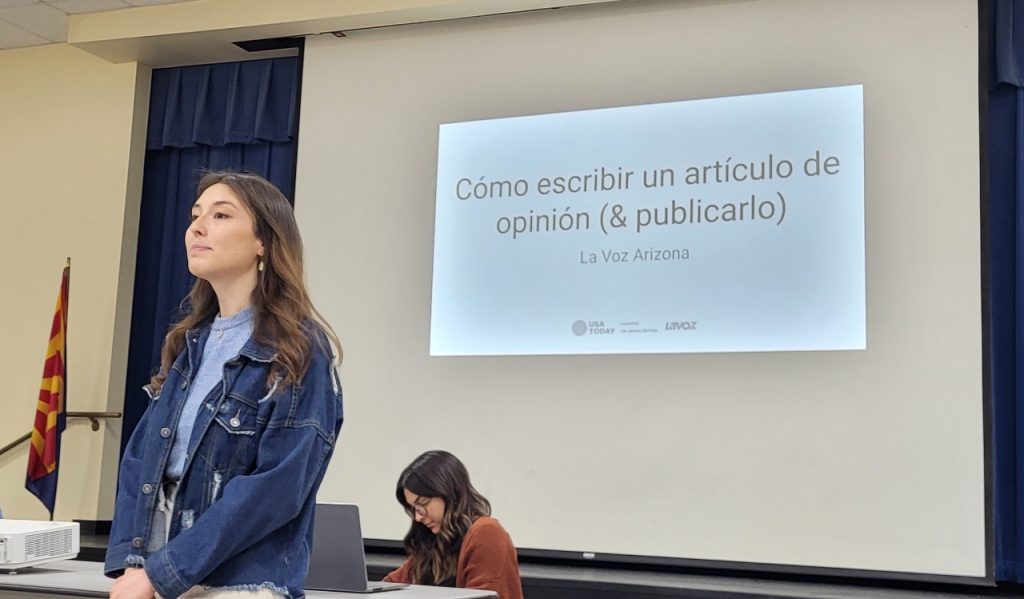
Feedback we received (translated from Spanish):
- All of the information was valuable, because I had no idea how labor intensive your job is.
- I plan on informing my community when I see someone share news that could be false, sharing the tips I learned about verifying where that info came from.
- Thank you for taking the time to come out to our community.
- I would like it if the sessions were longer, because these are important topics and two are not enough.
Our advice for other newsrooms is to plan according to the people you know you can count on. We looked across our newsroom and asked anyone we knew would be comfortable engaging with Spanish speakers and started planning the sessions from there. Prepping the curriculum was the biggest lift. If you have someone in your newsroom who has taught journalism courses, use them. I was able to pull from previous courses I’ve taught and formulate presentations and writing sessions based on that and resources from Factchequeado.
We set out to conduct these workshops with minimal expectations. We kept telling ourselves, ‘if we can just get one op-ed published, that’ll be well worth it.’ We got so much more out of that. Reporters, photographers, directors and interns were involved in this entire process. Those who were able to participate in the workshops have shared that it was one of the best experiences they’ve been a part of throughout their career. That speaks volumes.
Shared by Laura Daniella Sepúlveda and Joanna Jacobo Rivera
Mirror Indy

On May 16, we’re doing a community photo project with a local elementary school. The school’s fifth graders are going on a field trip, and we are providing 10 of the kids with disposable cameras. We will then turn their photos into a photo essay for our website and a video for our social media. Our kid reporter, Daya, will interview her classmates and ask them how they’re feeling about their last days of elementary school and the transition to middle school.
We’ve had a kid reporter for a while, but we wanted a way for her to connect with other kids. Giving students cameras also gives them the opportunity to tell their own stories, which is a new approach for us.
I learned that disposable cameras are more expensive than I thought. If you’re thinking about giving a group of people cameras for a similar community photo project, I’d suggest working with a local camera shop like we did. They let us buy bulk cameras and their prices were better.
Shared by Sophie Young
LA Public Press
LA Public Press published its first bilingual print newspaper in Dec 2024. We had guides on how the incoming administration might impact LA communities, a holiday guide, and a memories page. We distributed the paper to local businesses and community centers.
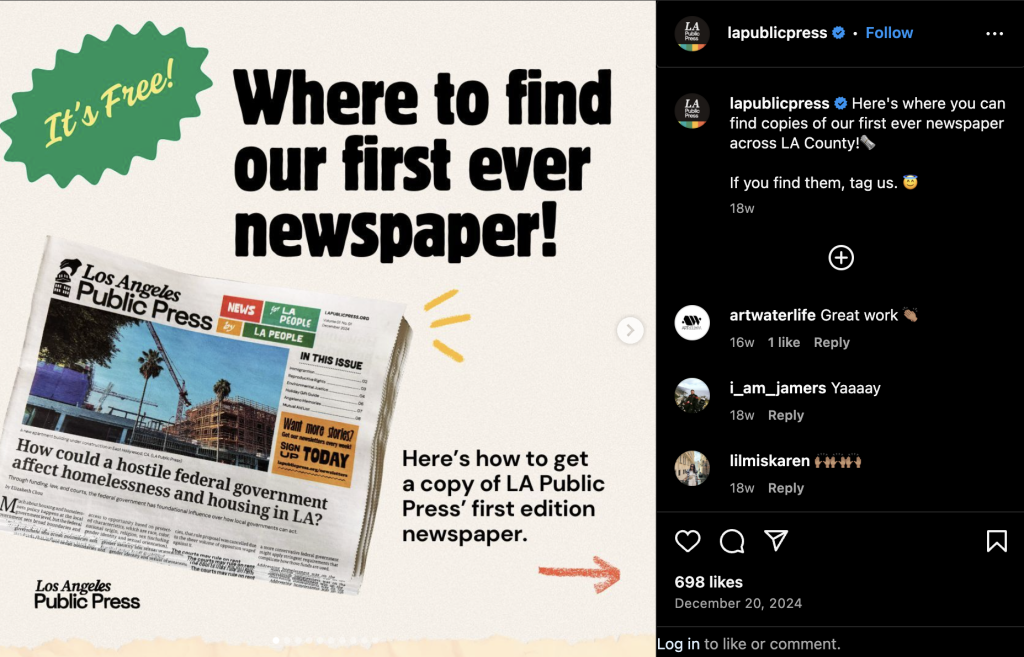
We had never done a print newspaper before, let alone print so many copies. We also distributed the papers more widely than any of our other printed projects. Residents and readers loved seeing our papers and posted and tagged us on social media.
From this experience I learned that working with a layout team would’ve been incredibly helpful, I also would’ve streamlined distribution a bit. I also learned that residents miss print news and want print news in LA.
Shared by Mariah Castaneda
Planeta Venus
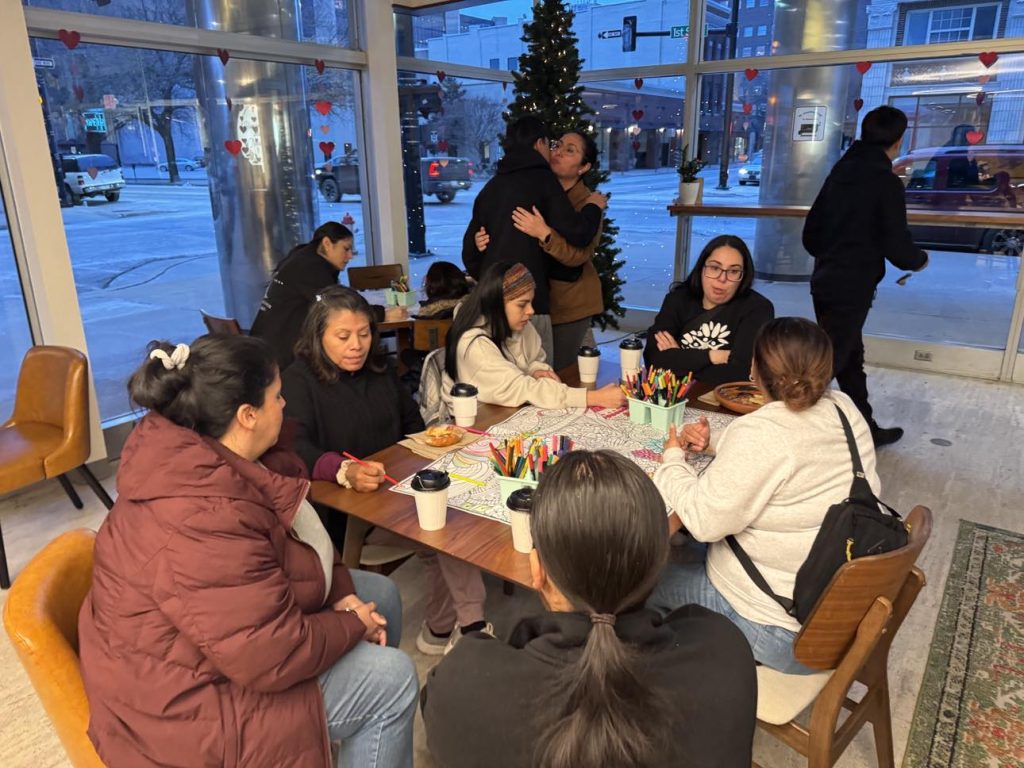
Following the Community-Centered Symposium, Planeta Venus organized an audience engagement event titled “Café, Amor y Colores”, in collaboration with Las Adelitas Coffee Co. The event was designed as a warm and accessible gathering where families could come together to enjoy a free cup of coffee, color with their children, and engage in open conversations about local news and community concerns.
Held in a welcoming, informal setting, the event aimed to foster trust between our bilingual newsroom and Spanish-speaking families, many of whom face barriers to accessing relevant and culturally-responsive information. As families colored together, Planeta Venus staff facilitated casual conversations and distributed short surveys to gather insights about the topics that matter most to our audience and their preferred platforms for receiving news.
The survey responses provided valuable feedback on local priorities, news coverage gaps, and media consumption habits, helping inform future editorial planning and audience engagement strategies. This event not only strengthened relationships with our community but also modeled an inclusive, joyful, and family-friendly approach to civic dialogue and journalism.
While our newsroom has previously hosted events and forums, this was the first time we created a space that intentionally combined cultural warmth, creativity, and informal conversation as a method for listening to our audience. The event allowed us to engage with parents and children simultaneously, creating a multi-generational dialogue around news access and community concerns.
The response was overwhelmingly positive, with many participants expressing gratitude for being invited to a space where they felt welcomed and heard.
Some examples of feedback included:
“Me encanta que este evento sea para toda la familia. Nunca había podido hablar con un medio de comunicación de esta manera.” (“I love that this event is for the whole family. I’ve never been able to talk to a news outlet like this before.”)
“Nos gustaría ver más noticias sobre educación, recursos para niños con necesidades especiales y lo que pasa en nuestras escuelas.” (“We’d like to see more news about education, resources for children with special needs, and what’s happening in our schools.”)
The surveys also revealed that many attendees rely on Facebook, and word of mouth to stay informed—highlighting the importance of distributing our content through social media and community networks. This feedback is now helping guide our editorial planning and outreach strategies moving forward.
We learned that meaningful community engagement doesn’t have to look like a formal forum or panel discussion—it can happen over coffee, crayons, and conversation. People are more open and honest when they feel relaxed, safe, and seen, and by creating a culturally familiar and joyful environment, we were able to build trust with families who often feel excluded from traditional media spaces.
We also learned the value of meeting people where they are—literally and emotionally. Hosting the event in a community space, inviting families with children, and using Spanish as the primary language all helped lower the barriers to participation. The simple act of listening—with no agenda beyond understanding—can have a powerful impact.
Shared by Claudia Yaujar-Amaro
Austin Vida
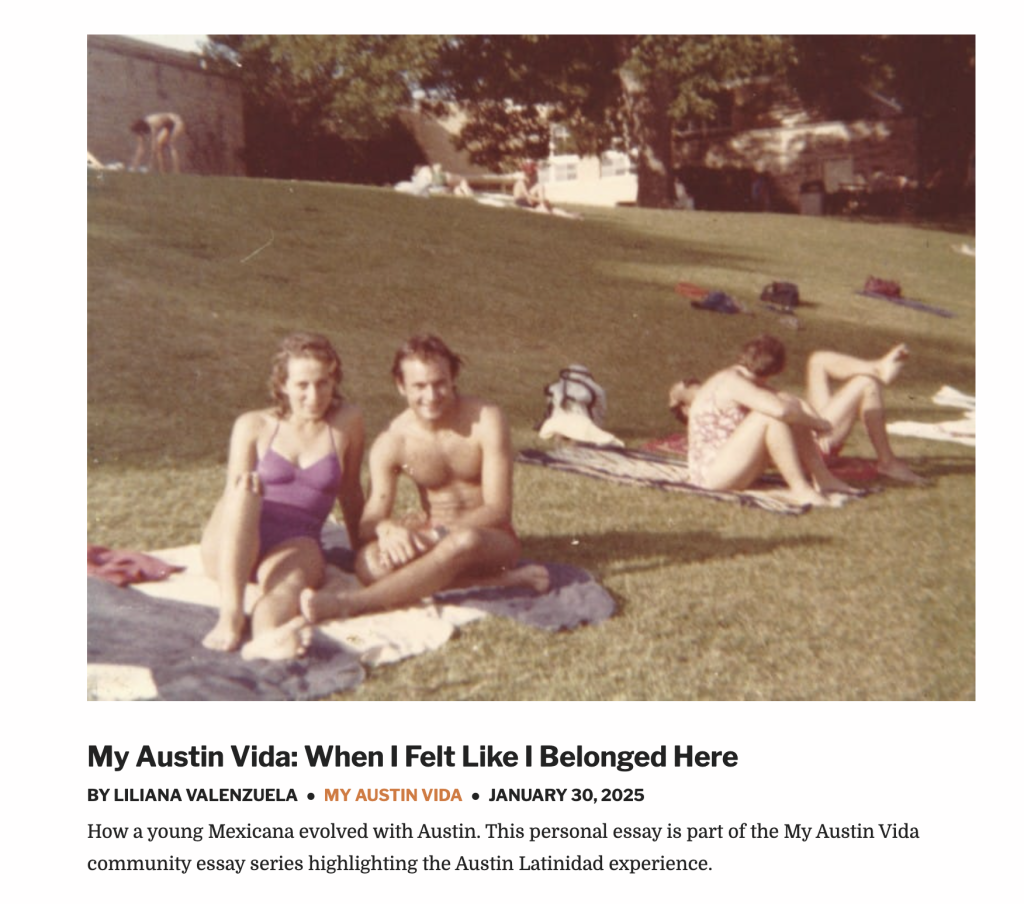
Austin Vida amplifies, informs and celebrates the stories of our local Austin, Texas, community with culturally-competent news. A big part of our mission is not only for us to tell those stories, but to create safe spaces for our residents to tell their OWN stories.
We launched a community essay series in January 2025 called My Austin Vida. It gives residents the opportunity to share their Austin Latine identity experiences through the lens of resilience. Over the past year, we collected and curated personal essays that touched on topics from “Finding Enoughness in Being Biracial ” to the immigrant experience in “When I Felt Like I Belonged Here.” At a time when anti-Latine rhetoric in the U.S. runs high, it’s important to tell these personal stories that go beyond the headlines to further create understanding.
We experienced incredible community support for our essay series, and now we see the need to take these stories offline and create the community connections that only happen with an in-person event. This June, we will pilot the My Austin Vida Community Reading, bringing together these essayists to read their work aloud in a local indie bookstore in community with others to further spark dialogue about the Austin Latine experience.
This project represents many firsts for our small newsroom. It was the launch of our first community personal essay series and it’ll be a pilot for what we hope becomes a regular essay series. We hope this pilot helps us create a proof of concept to make this a self-sustaining event. We’re also excited to work with a new partner for this project – Resistencia Bookstore. This longtime independent bookstore has long championed diverse stories and were the right mission-aligned partners for the community reading.
Since our project is still in progress, we’re still learning lessons! Some advice would be to not wait to launch a new project until every single element seems right. It can feel very risky to start new things but once we shifted our mindset to treating this like a “pilot,” it gave us permission to move forward faster without having to perfect every aspect of the original vision. We can still build towards that, but starting with something small helps to iterate along the way.
For small independent newsrooms, this work can often feel overwhelming. However, I remain inspired by journalists and this symposium that continues to center community work. Gracias!
Shared by Nancy Flores
Foothills Forum
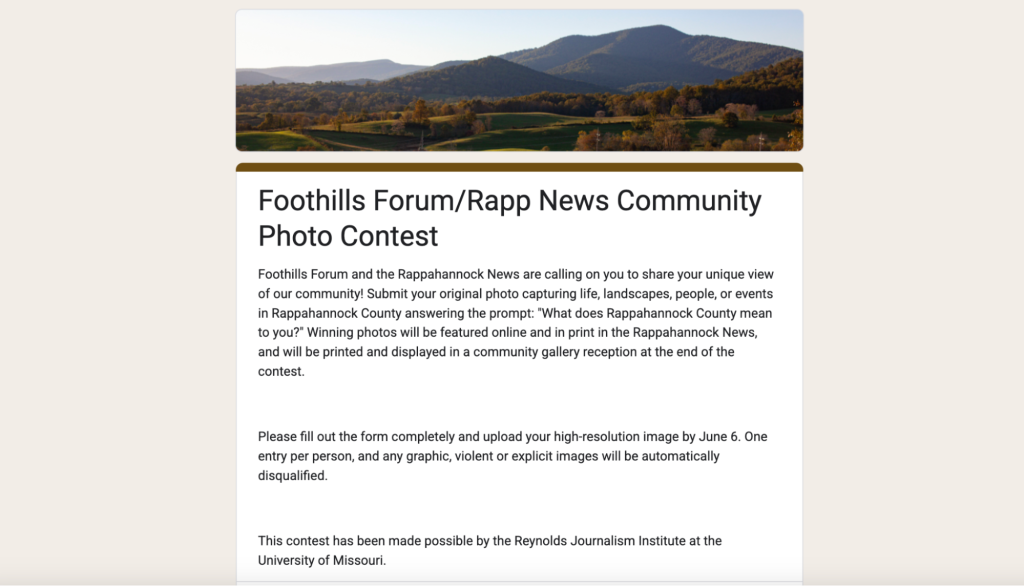
Foothills Forum is running a community photo contest, asking residents of Rappahannock County to submit photos that demonstrate what Rappahannock County means to them. After photos are collected, a panel of judges from across the community will select winners in several categories (best in show, best portrait, best landscape, best young photographer, etc.) and winners and honorable mentions will be professionally printed, and displayed in a community gallery reception this summer. Winners will also be published in the local newspaper that Foothills Forum supports — the Rappahannock News.
We have been trying to expand our digital presence, as well as visual content, and we thought a photo contest would be a good way to engage our community in a new way, and possibly reach community members or groups in the county we have not previously.
The contest is officially launching this week, so we have not had any feedback from the community at large yet. However, judges recruited to participate in choosing winners, which span from professional art curators to hobby photographers, are all excited for the opportunity, and have voiced optimism that the project will be well received.
As we prepare to launch the contest, I feel that we’ve already learned the value of designing projects that invite broader participation beyond our usual audiences. Unlike past efforts focused on student writing, this contest will engage residents of all ages and backgrounds, and we hope it will lead to more ideas and projects going forward that will celebrate local creativity, and build trust with our audience by valuing their points of view. We have a panel of judges, but we will also have a “people’s choice” category where people in the community will have a chance to vote on their favorites. I’ve learned that a lot more planning goes into organizing a project like this than I previously thought, and pulling a team in to help is very important to moving the development along. I’m excited and hopeful that this will help strengthen our newsroom’s relationship with the community we serve.
This has been such a great experience, and having the ability to be creative in a new way pulling the contest together has been fun. My newsroom team has collaborated in new ways pulling this together, and I think we are all eager to keep the momentum up, looking for more ways to engage with our community.
Shared by Ireland Hayes
Axios Boston
I launched a coworking meetup the first two Tuesdays of each month at a local cafe that’s friendly to coworkers. The idea was to give remote workers, acquaintances and other locals a chance to meet up together, brainstorm, do their own work and support a local business in the process. I offered free empanadas (with vegan and vegetarian options) for participants.
My news outlet’s Local Division had done subscriber events, but no recurring, public events that weren’t panel talks or roundtable discussions. This was a relatively low-lift way to get readers and the public to get together, promoting the Axios Boston newsletter in the process. Axios Boston has never had an event series like this before.
People who joined loved it. A participant even posted about it. They enjoyed working together and socializing. Others said they wish they could join, but their schedules didn’t match up, or they didn’t hear about it in time and want to join the next one. I need to do better at marketing and maybe make an online flyer. It’s hard to get things like that approved by work, but I should just do it myself anyway. I learned that things like this are worth it, but hard to pull off. And that there needs to be marketing in advance and both in person and online.
Shared by Steph Solis
The Green Line
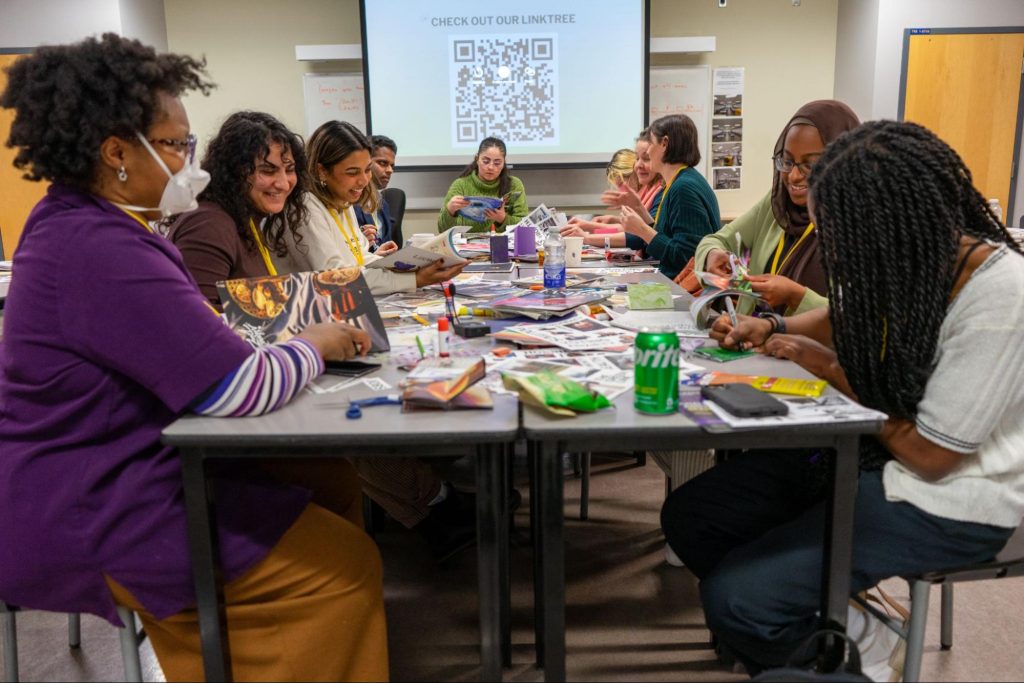
Participants engaged in zine-making as an accessible and creative method to explore democratic processes and election issues. Attendees received a non-partisan overview of party platforms and key election topics while crafting personalized zines. This process empowers participants to articulate their perspectives, concerns, and aspirations regarding Canada’s democratic future. No prior experience was required, and all materials were provided.
We held two major events, in partnership with the Toronto Public Library and DemocracyXChange. Collaborating with these value-aligned organizations allowed us to scale up our innovative approach and significantly broaden our reach and impact among Gen Zs and millennials.
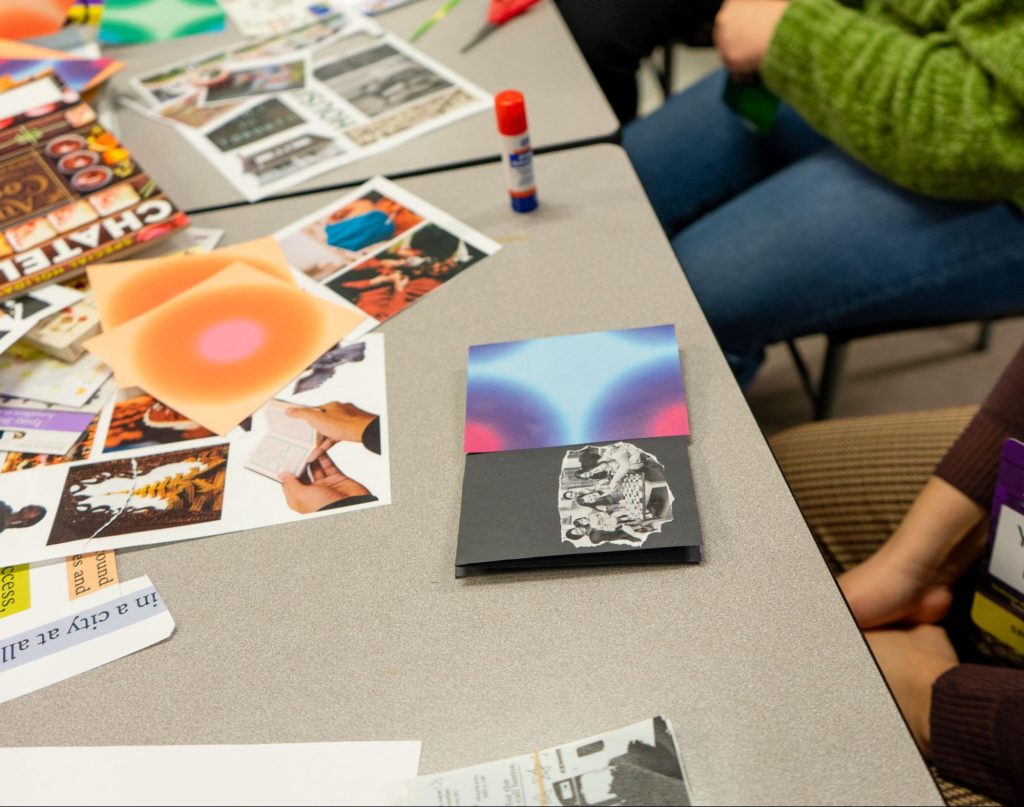
The engagement reporter for zines at the Green Line, Adele Lukusa, has had people share about the zine folding workshops:
- an easy/low barrier way to get creative
- great way to meet new people
- a good way to connect with others and yourself
- an intentional way to break from the online world
- very meditative and therapeutic
- a couple of folks have shared that they now make zines of their own accord for/with friends and family!
We’ve learned that it’s the perfect time for journalism, especially small and independent publications, to embrace the DIY spirit inherent to zines. It’s time to meet people where they are, to think beyond our screens and give people something tangible to hold on to. The Green Line’s zines have served as reminders that folks aren’t suffering individually, that solutions are ready and possible, that journalism exists beyond an article or Instagram carousel.
Shared by Anita Li
Canopy Atlanta

We have not worked with donation-based merchandise nor produced a zine before now. We had such a strong response for our larger, sleek magazine edition that featured arts and stories from our first five community issues. That magazine was distributed in coffee shops, libraries, community centers, businesses and in the neighborhoods where we had listened. These Zines are being produced similarly and distributed similarly, but these will be more cost-efficient and appeal to a younger audience.
Each Zine (we’re planning to print about 500) will include a QR code to the resource page for its specific community. To distribute these zines and amplify community engagement, we’d also like to design new commemorative merchandise that would be gifts for those who sign on or renew their donor support (of $100 or more). This will improve our fundraising efforts and grow our audience.
We are still in the early stages of developing these products. However, the latest mockup of our bags (which will be delivered in the next couple of weeks) has gotten positive reviews from our internal team. We did survey our supporters about different swag/donation items that they find appealing. A light, branded tote came up multiple times. Folks are also always asking us for printed editions of our community issues.
Shared by Stephanie Toone
Minnesota Women’s Press

Now that we have a part-time community engagement director, we are making it a priority finally to get into the community and meet them where they are at, with mini versions of our stories. Our first one was related to the women veterans issue we did in November. Another one was about a book dealing with tools to reduce polarization in conversation. A pocket-sized handout that is considerably cheaper than a full size enables us to share them much more widely to a larger audience as we visit communities around the state.
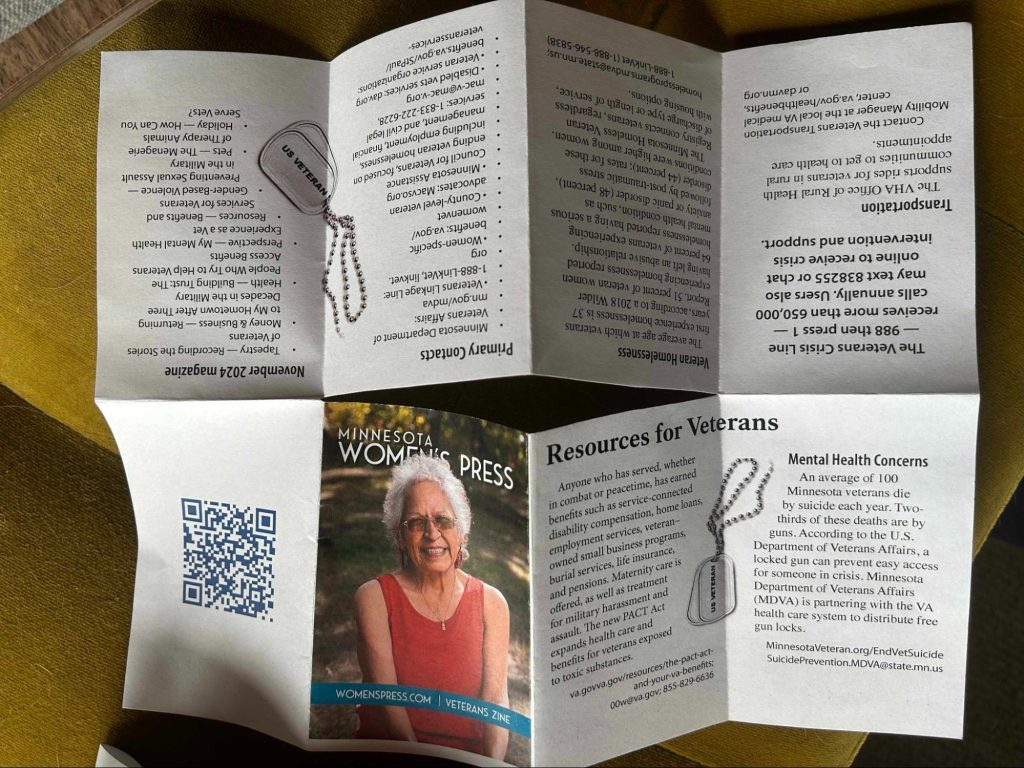
We do know at least one new Badass member picked up our Veterans mini-magazine and is now offering our basic $5/month membership fee, which more than pays for the printing of 100 copies.
We learned that the quality needs to be good, which is why we needed a newer printer. We tried one that requires more assembly, and one that is simpler to fold, and will stick to the simpler one for future to take up less staff time. It requires not trying to cram too much information on one mini page. Leave the back for a QR code to get memberships or subscriptions.
Shared by Mikki Morrissette
Cite this article
Duncan, Kat (2025, May 7). 12 community-centered news projects. Reynolds Journalism Institute. Retrieved from: https://rjionline.org/news/12-community-centered-news-projects/
